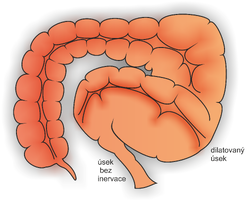Megacolon congenitum
From WikiLectures
Under construction / Forgotten
|
This article was marked by its author as Under construction, but the last edit is older than 30 days. If you want to edit this page, please try to contact its author first (you fill find him in the history). Watch the discussion as well. If the author will not continue in work, remove the template Last update: Wednesday, 22 Nov 2023 at 10.15 pm. |
This article has been translated from WikiSkripta; ready for the editor's review.
Congenital aganglionic megacolon (Hirschsprung's disease) is caused by abnormal innervation of the bowel, affecting the internal anal sphincter and the adjacent proximal segment of variable length.[1]
Epidemiology[edit | edit source]
- the most common cause of obstruction of the lower GIT in newborns;
- incidence 1:5000 live births;
- boys affected 4x more often than girls;
- may be associated with other birth defects, trisomy 21 or medullary carcinoma of the thyroid gland.[1]
Etiopathogenesis and pathophysiology[edit | edit source]
- disorder of neuroblast migration from the proximal to the distal intestine with subsequent absence of ganglion cells in the intestinal wall;
- histologically: absence of Meissner's and Auerbach's plexus with hypertrophic nerve endings and high concentration of acetylcholinesterase;
- classic form (75%): aganglionosis in the rectosigmoid; in 10% the entire colon is affected; ultrashort form: aganglionic section in the rectum 1-3 cm long;
- the aganglionic section is permanently contracted (missing inhibitory neurons) and causes functional obstruction → the healthy intestine above it dilates and hypertrophies to form a megacolon.[1]
Clinical picture[edit | edit source]
- in 90% of cases, manifestation immediately after birth: late departure of the pitchfork;
- milder forms: chronic constipation, failure to thrive, gradually developing abdominal distension with overgrowth of pathogens and symptoms of enterocolitis to sepsis;
- the onset of difficulties in infancy is typical (often after the introduction of non-dairy foods): increased tone of the internal sphincter, small volume of stool during defecation, smearing does not occur;
- for ultra-short English section, stool accumulates in the rectum, the sphincters gradually weaken, soiling + paradoxical diarrhea (dirty laundry).[1]
Diagnosis[edit | edit source]
- irrigography – after previous emptying of the intestine with enemas, delayed evacuation, transition zone between the narrow distal aganglionic segment and the proximally dilated section of the intestine; defecogram;
- anorectal manometry – measurement of anal pressure when a balloon is inflated in the rectum (anal pressure does not decrease, or paradoxically increases);
- rectal biopsy (may be false negative for ultrashort segment).[1]
Therapy[edit | edit source]
- surgical solution; prognosis is good, most patients maintain continence.[1]
Complications[edit | edit source]
- toxic megacolon with a septic course with the risk of secondary meningitis or bowel perforation.[2]
Notes[edit | edit source]
- Megacolon idiopathicum: disorder of autonomic innervation - imbalance between sympathetic and parasympathetic.
- Megacolon symptomaticum: dilatation over a stenotic site - e.g. congenital stenosis, scar after surgery...[3]
Links[edit | edit source]
Related Articles[edit | edit source]
References[edit | edit source]
- ↑ a b c d e f LEBL, J – JANDA, J – POHUNEK, P, et al. Clinical Pediatrics. 1. edition. Galen, 2012. 698 pp. pp. 308-309. ISBN 978-80-7262-772-1.
- ↑ MUNTAU, Ania Carolina. Pediatrics. 4. edition. Prague : Grada, 2009. pp. 367-368. ISBN 978-80-247-2525-3.
- ↑ BENEŠ, Jiří. Study materials [online]. ©2007. [cit. 2010-04]. <http://www.jirben.wz.cz/>.



